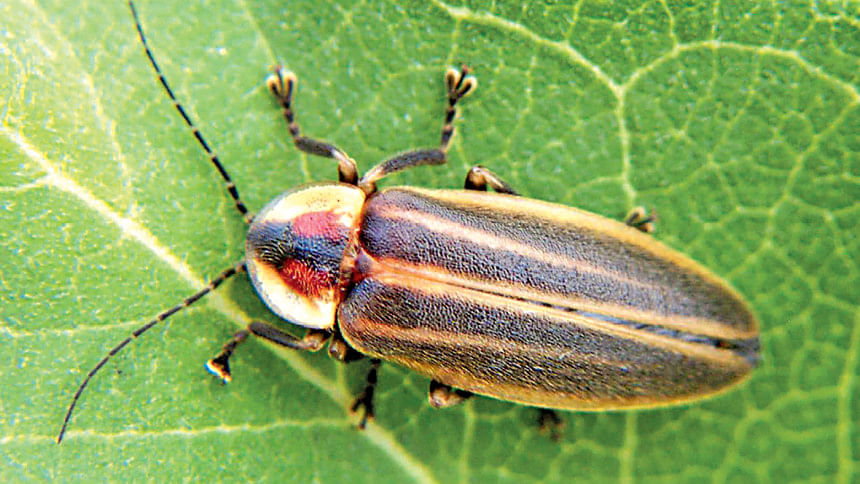"September 21, 1945, that was the night I died."
This iconic opening from the animated film Grave of the Fireflies speaks not only of war and loss but also of the silent tragedies unfolding in our world today. One such tragedy is happening in our backyards, forests, and wetlands—the quiet vanishing of fireflies.
Once a common sight lighting up warm summer nights, fireflies—locally known as jonaki poka—are rapidly disappearing, and scientists fear that we may be the last generation to witness their glow. Their fading presence is not just an ecological concern but also a symbol of how environmental pollution and climate change are extinguishing natural wonders.
Why Are Fireflies Disappearing?
Fireflies are among nature's most magical insects, but their survival depends on specific environmental conditions: clean water, moist soil, and dark, undisturbed nights. Today, these conditions are vanishing due to four major causes:
1. Light Pollution
Fireflies glow to communicate and find mates, but excessive artificial lighting from street lamps, buildings, and vehicles drowns out their natural signals. In urban areas like Dhaka, fireflies have almost disappeared due to constant illumination. A study published in BioScience confirmed that artificial light at night is one of the greatest threats to firefly reproduction.
2. Habitat Destruction
Rapid urbanisation, deforestation, and wetland encroachment across Bangladesh have destroyed the moist, shaded habitats where fireflies thrive. When trees are cut down and marshlands filled in, we lose more than biodiversity—we lose living beauty.
3. Pollution and Pesticides
Firefly larvae depend on moist soil rich in organic matter and small creatures like snails. But chemical pesticides used in agriculture and household mosquito fogging kill both the fireflies and their food sources. Water and soil pollution from plastic, sewage, and industrial waste have made many environments uninhabitable for these delicate insects.

4. Climate Change
Unpredictable weather, intense droughts, sudden floods, and shifting temperatures—all consequences of climate change—disrupt the life cycle of fireflies. Some species require specific temperature and moisture levels to develop. Without them, eggs fail to hatch or larvae perish before maturing.
What Happens If They're Gone?
The disappearance of fireflies is more than a loss of nostalgia—it is a warning sign.
• Ecological Collapse: Fireflies are predators in their larval stage, helping to keep pest populations in check. Their disappearance could destabilise local ecosystems.
• Cultural Loss: In literature, folklore, and childhood memories, fireflies hold a place of wonder. Their absence represents the fading of a shared natural heritage.
• Environmental Alarm: Fireflies are environmental indicators. Their decline points to deeper issues—polluted water, degraded soil, disappearing forests—that also threaten human health and wellbeing.
"Fireflies are not just beautiful; they are ecological indicators. When fireflies vanish, it tells us something is wrong with our environment—be it water quality, habitat integrity, or chemical contamination. Their decline in Bangladesh is a red flag. If we don't take immediate conservation steps, it won't just be the fireflies we lose, but the overall health of our ecosystems," says Dr Md Shahinur Rahman, Entomologist and Professor, Department of Zoology, University of Dhaka.
How Can We Stop This?
Though the situation is dire, it is not hopeless. Fireflies can still be saved—if we act now.
As Individuals:
• Switch off unnecessary outdoor lights at night, especially during the monsoon and summer months when fireflies breed.
• Avoid chemical pesticides and fogging; use organic alternatives.
• Create small natural habitats: leave leaf litter in your garden, maintain a moist corner, or plant native grasses and shrubs.
• Educate others. Teach children about fireflies and the environment. Encourage appreciation through observation, not collection.
As Communities and Policymakers:
• Implement dark-sky policies in parks and rural areas to reduce light pollution.
• Protect wetlands, riverbanks, and forests that serve as critical habitats.
• Monitor and regulate pesticide use, especially during firefly breeding seasons.
• Support environmental awareness campaigns and scientific research on native species and climate resilience.
If we act wisely—if we reconnect with the rhythms of nature—fireflies might continue to grace our evenings. But if we remain indifferent, their light will become just another casualty of a world we failed to protect.
Let us not be the generation remembered for letting the firefly fade. Let us be the ones who saw the glow dimming—and chose to bring it back.
Afrina Momotaj is a Climate-Smart Agriculturist and Animal Rescuer. She can be reached at [email protected].


Comments